
The French Quarter, also known as the Vieux Carré and Barrio Francés, is the oldest neighborhood in the city of New Orleans. After New Orleans was founded in 1718 by Jean-Baptiste Le Moyne de Bienville, the city developed around the Vieux Carré, a central square. The district is more commonly called the French Quarter today, or simply "The Quarter," related to changes in the city with American immigration after the 1803 Louisiana Purchase. Most of the extant historic buildings were constructed either in the late 18th century, during the city's period of Spanish rule, or were built during the first half of the 19th century, after U.S. annexation and statehood.

Union Square is a historic intersection and surrounding neighborhood in Manhattan, New York City, located where Broadway and the former Bowery Road – now Fourth Avenue – came together in the early 19th century. Its name denotes that "here was the union of the two principal thoroughfares of the island". The current Union Square Park is bounded by 14th Street on the south, 17th Street on the north, and Union Square West and Union Square East to the west and east respectively. 17th Street links together Broadway and Park Avenue South on the north end of the park, while Union Square East connects Park Avenue South to Fourth Avenue and the continuation of Broadway on the park's south side. The park is maintained by the New York City Department of Parks and Recreation.

Astor Place is a one-block street in NoHo/East Village, in the lower part of the New York City borough of Manhattan. It runs from Broadway in the west to Lafayette Street, ending at Alamo plaza. "Astor Place" is also sometimes used for the neighborhood around the street. It encompasses two plazas at the intersection with Cooper Square, Lafayette Street, Fourth Avenue, and Eighth Street – Alamo Plaza and Astor Place Station Plaza. It was named for John Jacob Astor, soon after his death in 1848. A $21 million reconstruction to implement a redesign of Astor Place began in 2013 and was completed in 2016.
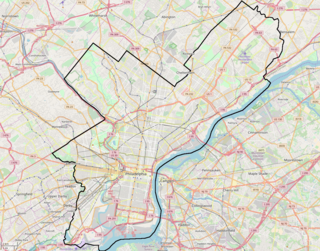
The Bellevue-Stratford Hotel is a landmark building at 200 S. Broad Street at the corner of Walnut Street in Center City, Philadelphia, Pennsylvania United States. Constructed in 1904 and expanded to its present size in 1912, it has continued as a well-known institution for more than a century and is still widely known by that original, historic name. In 1988 the building was converted to a mixed-use development. It has been known since then as The Bellevue. The hotel portion is currently managed by Hyatt as The Bellevue Hotel.
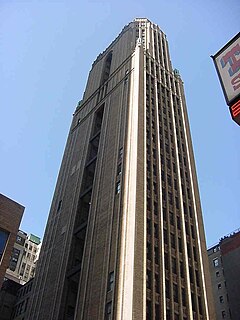
Bush Tower, also called the Bush Terminal International Exhibit Building and formerly as the Bush Terminal Sales Building, is a historic 30-story, 433-foot-tall (132 m) skyscraper located in Midtown Manhattan, New York City, just east of Times Square. The building occupies a plot at 130-132 West 42nd Street between Broadway and Sixth Avenue. It was built in 1916–1918 for Irving T. Bush's Bush Terminal Company, which operated Bush Terminal in the Sunset Park neighborhood of Brooklyn, New York City.

Hotel Astor was a hotel located in the Times Square area of Manhattan, New York City, in operation from 1904 through 1967. The former site of the hotel, the block bounded by Broadway, Astor Plaza, West 44th Street, and West 45th Street, is now occupied by the high-rise 54-story office tower One Astor Plaza.

The Astor House was the first luxury hotel in New York City. Located on the corner of Broadway and Vesey Street in what is now the Civic Center and Tribeca neighborhoods of Lower Manhattan, it opened in 1836 and soon became the best known hotel in America.

The St. Regis New York is a historic luxury hotel that opened in 1904. It is located at 2 East 55th Street in Manhattan, New York City, between Madison Avenue and Fifth Avenue. The hotel holds Forbes five-star and AAA five-diamond ratings.

Cooper Square is a junction of streets in Lower Manhattan, New York City located at the confluence of the neighborhoods of Bowery to the south, NoHo to the west and southwest, Greenwich Village to the west and northwest, the East Village to the north and east, and the Lower East Side to the southeast.
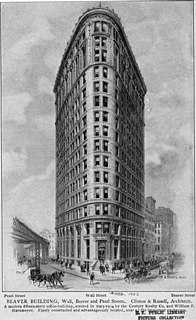
Clinton and Russell was a well-known architectural firm founded in 1894 in New York City, United States. The firm was responsible for scores of notable New York City buildings, downtown and throughout the city.

Istithmar World is an investment firm based in Dubai, United Arab Emirates (UAE). This company is a state-run business owned by Dubai World, a Dubai government-owned company, and was established in 2003. Originally known as "Istithmar," the company was renamed as "Istithmar World" in 2008.
SL Green Realty Corp. is a real estate investment trust that primarily invests in office buildings and shopping centers in New York City. As of December 31, 2019, the company owned 43 properties comprising 14,438,964 square feet. Notable properties owned by the company are One Astor Plaza, One Vanderbilt, 461 Fifth Avenue, 810 Seventh Avenue, 919 Third Avenue, the Pershing Square Building, and Random House Tower.

The Sherry-Netherland is a 38-story apartment hotel located at 781 Fifth Avenue on the corner of East 59th Street in the Upper East Side neighborhood of Manhattan, New York City. It was designed and built by Schultze & Weaver with Buchman & Kahn. The building is 560.01 feet (170.69 m) high, and was noted as the tallest apartment-hotel in New York City when it opened.

NoMad, also known as Madison Square North, is a neighborhood centered on the Madison Square North Historic District in the borough of Manhattan in New York City.
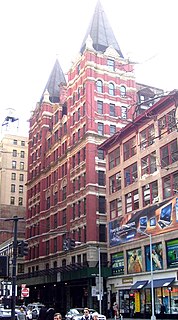
5 Beekman Street, also known as the Beekman Hotel and Residences, is a building in the Financial District of Manhattan in New York City. It is composed of the interconnected 10-story, 150-foot-tall (46 m) Temple Court Building and Annex and a 51-story, 687-foot-tall (209 m) condominium tower called the Beekman Residences, which contains 68 residential units. The 287-unit Beekman Hotel is split between all three structures.

The Hamilton Hotel, formerly known as the Hamilton Crowne Plaza, is an AAA 4-diamond luxury hotel in downtown Washington, D.C., United States, located at 1001 14th Street, N.W., just to the north of Franklin Square. In September 2017, the hotel became independent from the Crowne Plaza hotel chain.
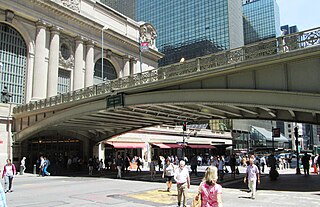
Pershing Square is a public square in Manhattan, New York City, located where Park Avenue and 42nd Street intersect in front of Grand Central Terminal. The main roadway of Park Avenue crosses over 42nd Street on the Park Avenue Viaduct, also known as the Pershing Square Viaduct. Two service roads, one northbound and one southbound, connect 42nd Street with the main roadway of Park Avenue, at 40th Street.

The Pabst Hotel occupied the north side of 42nd Street in Manhattan, New York City, between 7th Avenue and Broadway, in Longacre Square, from 1899 to 1902. It was demolished to make room for the new headquarters of The New York Times, for which Longacre Square was renamed Times Square.

The Park Lane Hotel is a New York City luxury hotel located at 36 Central Park South, between Fifth and Sixth Avenues in Midtown Manhattan, overlooking Central Park. Constructed in 1971, the hotel was designed by the prolific architecture firm, Emery Roth & Sons, for prominent New York City real estate developer Harry Helmsley. The Hotel currently operates under the ownership of Steve Witkoff’s real estate investment firm, the Witkoff Group. A supertall skyscraper has been planned for the site, though that has been placed on hold.


























